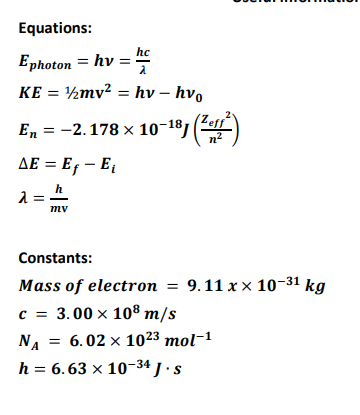la) Calculate the photon energy associated with a transition from the n = 2 level to the n = 6 level in a He+ ion. Note: Mathematically, values of the quantum number n are considered to have infinite sig figs. b) Is a photon being absorbed or emitted in this transition? c) Without any calculation, would you expect the photon energy to be larger or smaller for the transition from the n = 1 level to then = 6 level?
la) Calculate the photon energy associated with a transition from the n = 2 level to the n = 6 level in a He+ ion. Note: Mathematically, values of the quantum number n are considered to have infinite sig figs. b) Is a photon being absorbed or emitted in this transition? c) Without any calculation, would you expect the photon energy to be larger or smaller for the transition from the n = 1 level to then = 6 level?
Chemistry & Chemical Reactivity
9th Edition
ISBN:9781133949640
Author:John C. Kotz, Paul M. Treichel, John Townsend, David Treichel
Publisher:John C. Kotz, Paul M. Treichel, John Townsend, David Treichel
Chapter6: The Structure Of Atoms
Section: Chapter Questions
Problem 11PS: An energy of 3.3 1019 J/atom is required to cause a cesium atom on a metal surface to lose an...
Related questions
Question

Transcribed Image Text:la) Calculate the photon energy associated with a transition from the n = 2 level to the n = 6
level in a He+ ion. Note: Mathematically, values of the quantum number n are considered to
have infinite sig figs.
b) Is a photon being absorbed or emitted in this transition?
c) Without any calculation, would you expect the photon energy to be larger or smaller for the
transition from the n = 1 level to then = 6 level?

Transcribed Image Text:Equations:
hc
Ephoton = hv = ne
KE = ½mv² = hv – hv,
En = -2.178 x 10-18, ()
AE = E, – E
mv
Constants:
Mass of electron = 9.11 x × 10-31
c = 3.00 x 108 m/s
NA = 6.02 x 1023 mol-1
h = 6.63 x 10-34 J ·s
Expert Solution
This question has been solved!
Explore an expertly crafted, step-by-step solution for a thorough understanding of key concepts.
This is a popular solution!
Trending now
This is a popular solution!
Step by step
Solved in 2 steps with 2 images

Knowledge Booster
Learn more about
Need a deep-dive on the concept behind this application? Look no further. Learn more about this topic, chemistry and related others by exploring similar questions and additional content below.Recommended textbooks for you

Chemistry & Chemical Reactivity
Chemistry
ISBN:
9781133949640
Author:
John C. Kotz, Paul M. Treichel, John Townsend, David Treichel
Publisher:
Cengage Learning

Chemistry & Chemical Reactivity
Chemistry
ISBN:
9781337399074
Author:
John C. Kotz, Paul M. Treichel, John Townsend, David Treichel
Publisher:
Cengage Learning

General Chemistry - Standalone book (MindTap Cour…
Chemistry
ISBN:
9781305580343
Author:
Steven D. Gammon, Ebbing, Darrell Ebbing, Steven D., Darrell; Gammon, Darrell Ebbing; Steven D. Gammon, Darrell D.; Gammon, Ebbing; Steven D. Gammon; Darrell
Publisher:
Cengage Learning

Chemistry & Chemical Reactivity
Chemistry
ISBN:
9781133949640
Author:
John C. Kotz, Paul M. Treichel, John Townsend, David Treichel
Publisher:
Cengage Learning

Chemistry & Chemical Reactivity
Chemistry
ISBN:
9781337399074
Author:
John C. Kotz, Paul M. Treichel, John Townsend, David Treichel
Publisher:
Cengage Learning

General Chemistry - Standalone book (MindTap Cour…
Chemistry
ISBN:
9781305580343
Author:
Steven D. Gammon, Ebbing, Darrell Ebbing, Steven D., Darrell; Gammon, Darrell Ebbing; Steven D. Gammon, Darrell D.; Gammon, Ebbing; Steven D. Gammon; Darrell
Publisher:
Cengage Learning

Chemistry for Engineering Students
Chemistry
ISBN:
9781337398909
Author:
Lawrence S. Brown, Tom Holme
Publisher:
Cengage Learning

Chemistry: The Molecular Science
Chemistry
ISBN:
9781285199047
Author:
John W. Moore, Conrad L. Stanitski
Publisher:
Cengage Learning

Chemistry by OpenStax (2015-05-04)
Chemistry
ISBN:
9781938168390
Author:
Klaus Theopold, Richard H Langley, Paul Flowers, William R. Robinson, Mark Blaser
Publisher:
OpenStax